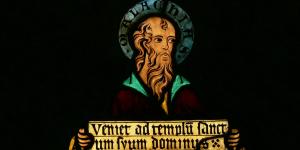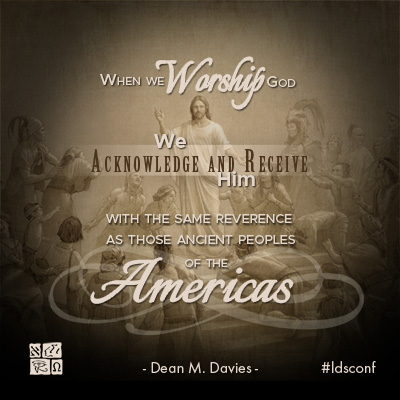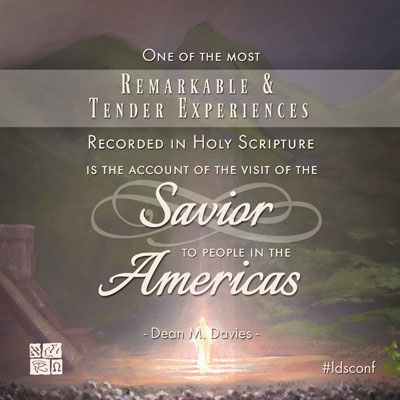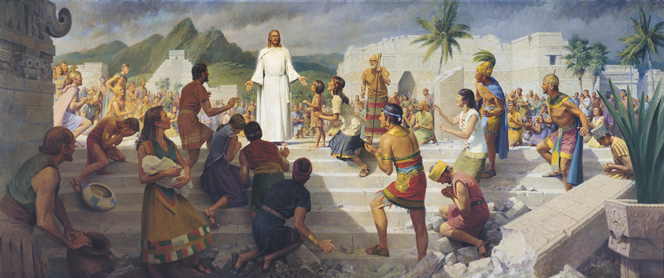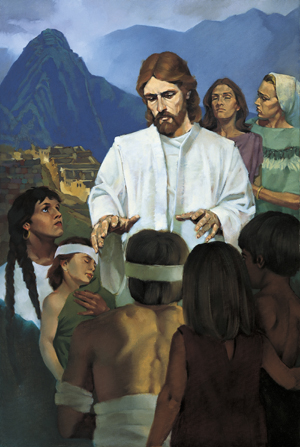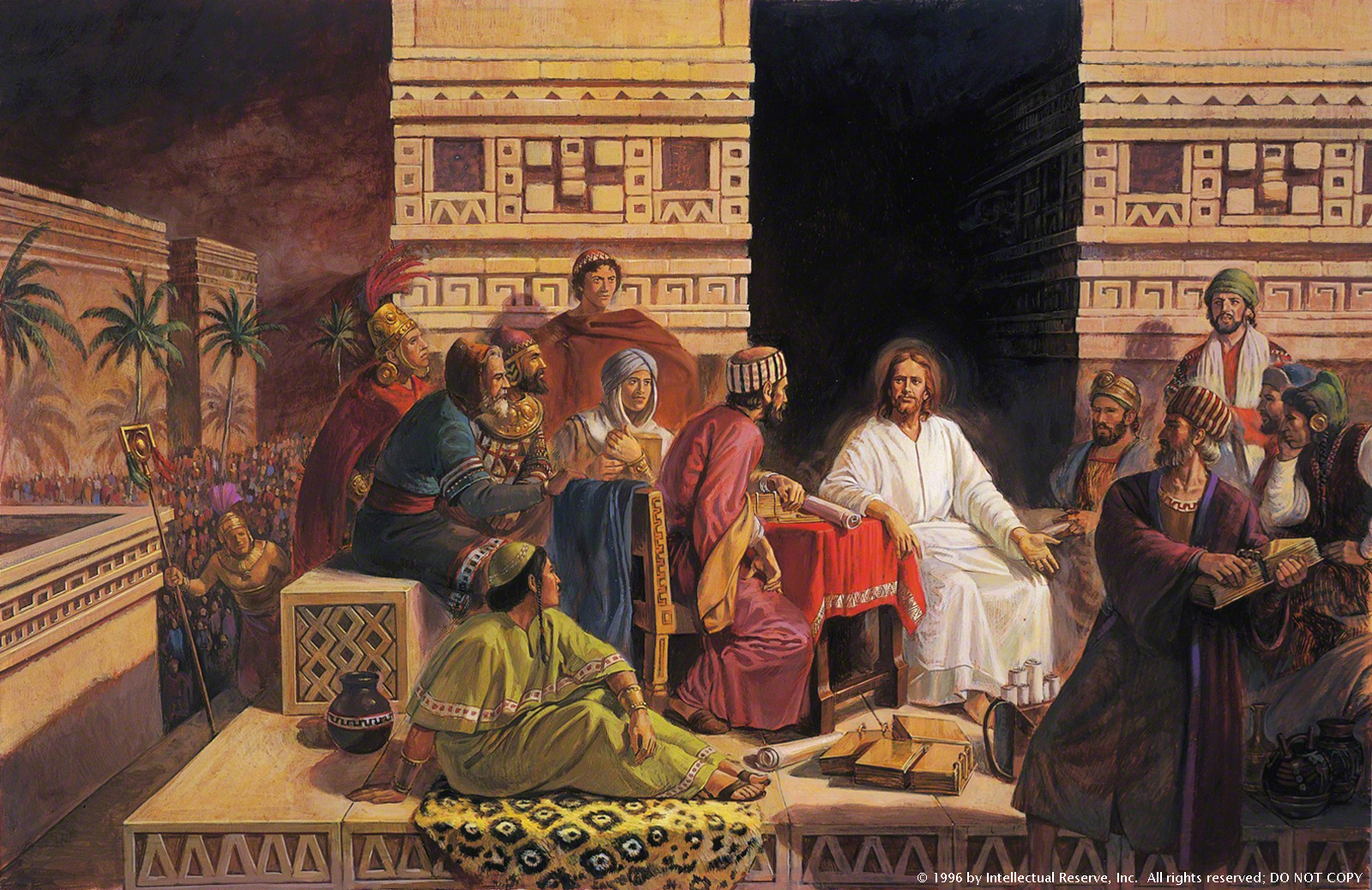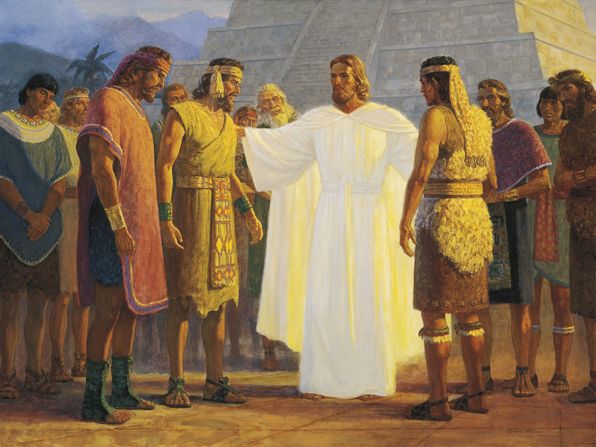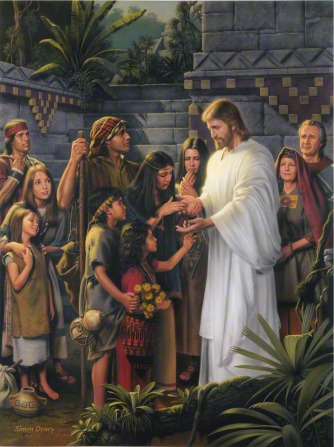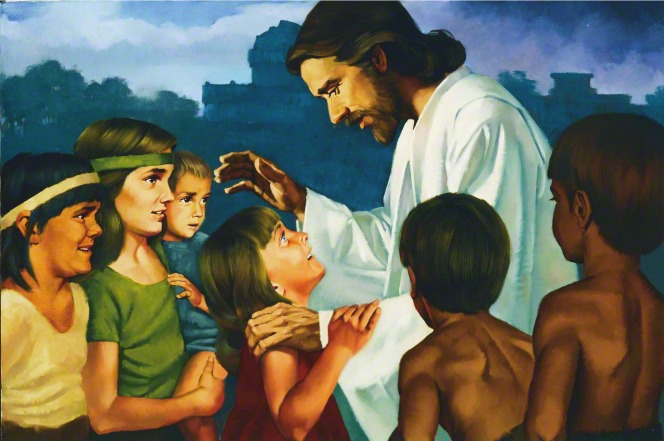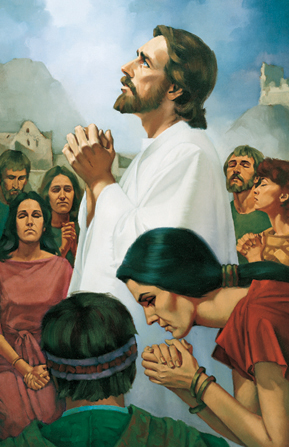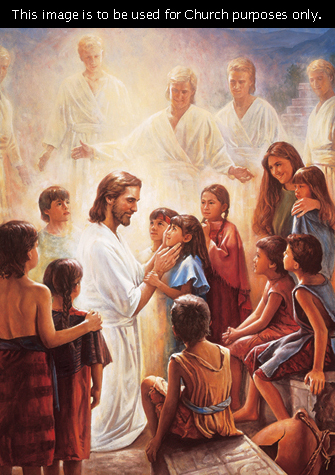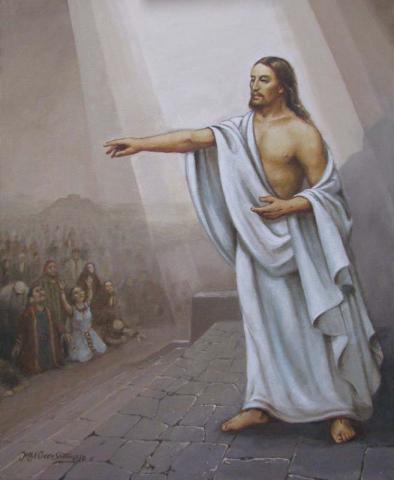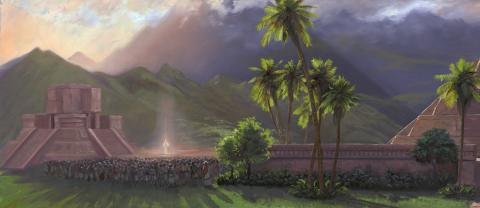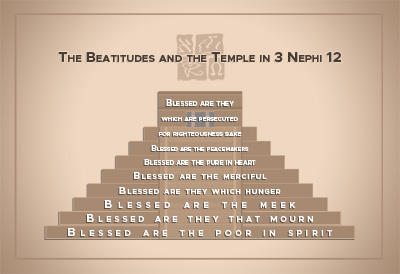You are here
Gospel Doctrine Lesson #41: He Did Expound All Things Unto Them

Scripture Block
3 Nephi 22-26
To help class members earnestly desire to search the words of the prophets.
Lesson Manual
KnoWhys

Why Did Jesus Quote All of Isaiah 54?
3 Nephi 22:5

Why Would Jesus Call Isaiah’s Words Great?
3 Nephi 23:1

Why Are Children So Prominent in 3 Nephi?
3 Nephi 26:14
Articles
Overview
Benson, Ezra Taft. "The Savior's Visit to America." General Conference Address April 1987.
A conference address from President Ezra Taft Benson on Christ's ministry among the Nephites in 3 Nephi.
Bokovoy, David E., and John A. Tvedtnes. "Christ in the Old Testament and the Book of Mormon." In Testaments: Links between the Book of Mormon and the Hebrew Bible, 7-23. Toelle, UT: Heritage Press, 2003.
All of the key events, doctrines, and people of the Hebrew Bible point directly to Jesus’ role as the Anointed One of Israel. This is the inspired message proclaimed so passionately by the ancient authors of the Book of Mormon: Jesus is the link between the Book of Mormon and the Hebrew Bible.
Holland, Jeffrey R.. Atonement of Jesus Christ In Encyclopedia of Mormonism, Edited by Daniel H. Ludlow. Vol. 1. New York: Macmillan, 1992.
An encyclopedic entry on the Atonement of Jesus Christ, as explained by Elder Jeffrey R. Holland. The Atonement is the core tenet of Christianity, and is the central focus of the Book of Mormon.
Ludlow, Victor L.. "Covenant Teachings in the Book of Mormon." In The Fulness of the Gospel: Foundational Teachings from the Book of Mormon, edited by Camille Fronk Olson, Brian M. Hauglid, Patty Smith and Thomas A. Wayment, 225-245. Provo, UT: Religious Studies Center, 2003.
This article discusses all the cases where Christ made covenants with his people in the Book of Mormon. Of note is the instance in 3 Nephi, when Christ visites the Nephites in the Americas and puts away the Law of Moses for a new covenant.
Matthews, Robert J.. "Jesus the Savior in 3 Nephi." In The Book of Mormon: 3 Nephi 9-30, This is My Gospel, edited by Monte S. Nyman and Charles D. Tate, Jr., 25-39. Provo, UT: Religious Studies Center, 1993.
This article discusses Jesus Christ's role in 3 Nephi. Third Nephi offers greater insight into the activity and scope of Jesus' work than that found in the New Testament alone. Matthew discusses the anticipation of Christ's coming, his miraculous appearance in the Americas, the doctrines he taught, and how Jesus Christ's coming is significant for the message of the Book of Mormon and the Gospel of Jesus Christ.
Millet, Robert L., Gary Lee Walker, Jerry C. Giles, Gerald Hansen, Jr., Andrew C. Skinner, Philip J. Schaelling, Daniel C. Peterson, Merril C. Oaks, Tad R. Callister, John Gee et al. Jesus Christ In Encyclopedia of Mormonism, Edited by Daniel H. Ludlow. Vol. 2. New York: Macmillan, 1992.
Encyclopedic entry on Jesus Christ, as he is understood in Mormon theology. Jesus Christ plays a central role in the Book of Mormon, especially when he appears to the Nephites in 3 Nephi.
Nelson, Russell M.. "Jesus the Christ - Our Master and More." In A Book of Mormon Treasury: Gospel Insights from General Authorities and Religious Educators, 19-31. Provo, UT: Religious Studies Center, 2003.
In a thoughtful overview, Elder Russell M. Nelson discusses how Jesus Christ fulfills each of Biblical and Book of Mormon titles attributed to him.
Seely, David R.. Jehovah, Jesus Christ In Encyclopedia of Mormonism, Edited by Daniel H. Ludlow. Vol. 2. New York: Macmillan, 1992.
An Encycopedic entry emphasizing the messianic role of Jesus Christ in Mormonism. Jesus Christ is the Jehovah and God of the Old Testament and was prophesied to come down to earth to redeem his people.
Tanner, N. Eldon. "Christ in America," Ensign. May 1975.
A Conference address from the First Counselor in the First Presidency on Christ in America. Starting with Biblical prophecies of Christ, President Tanner tells the story of Christ's appearance, expounding on the doctrines Christ layed out to the Nephites.
Turner, Rodney. "Christ's Church in America." Ensign. March 2000.
The Church of Jesus Christ experienced three phases in Book of Mormon times: the Old Testament-era Church among the early Nephites, the revitalization of the Church in Alma’s time, and the Church organized by the risen Lord.
Welch. John W. "Seeing Third Nephi as the Holy of Holies of the Book of Mormon." Journal of the Book of Mormon and Restoration Scripture 19, no. 1 (2010): 36-55.
Third Nephi and its account of the ministry of the resurrected Jesus to the Nephites has long been seen as the pinnacle of the Book of Mormon. This text can also be viewed as the Holy of Holies of the Book of Mormon. Everything in 3 Nephi, especially the ministry of the Savior, echoes themes related to the temple and the presence of the Lord in the Holy of Holies. Themes such as silence, timelessness, unity, awe, and consecration confirm this interpretation.
Hyde, Paul Nolan. A Comprehensive Commentary of the Book of 3 Nephi. Orem, UT: Parrish Press, 2015.
Kimball, Linda Hoffman. "The Coming of Christ." In The Reader's Book of Mormon: The Coming of Christ: Helaman 5 – 3 Nephi, edited by Robert A. Rees and Eugene England, vii-xxix. Salt Lake City: Signature Books, 2008.
3 Nephi 22
Hallen, Cynthia L. "Redeeming the Desolate Woman: The Message of Isaiah 54 and 3 Nephi 22." Journal of Book of Mormon Studies 7, no. 1 (1998): 40-47.
Third Nephi 22 (quoting Isaiah 54) addresses a desolate woman who will be redeemed in the latter days. The desolate woman represents Zion, and the Lord promises to relieve the desolation of Zion felt through barrenness, lack of a permanent home, and being forsaken and persecuted. The destiny of Zion parallels the pattern of Noah—both remain faithful to their covenants and witness a cleansing of the earth. The Savior serves as Zion’s husband. The servants of the Lord are equated with Zion—the Lord will not allow oppressors to be successful against Zion. The Lord promises to redeem Zion as he sings a song of redeeming love.
Hallen, Cynthia L. "The Lord's Covenant of Kindness: Isaiah 54 and 3 Nephi 22." In Isaiah and the Book of Mormon. Edited by Donald W. Parry and John W. Welch. Provo, UT: FARMS, 1998.
Similar to her JBMS article, Cynthia Hallen discusses Isaiah 54 and its use in 3 Nephi. As remnants of the House of Israel, the Nephites are recipients of the blessings of that covenant as they are true and faithful to it.
Davis, Garold N. "Pattern and Purpose of the Isaiah Commentaries in the Book of Mormon." In Mormons, Scripture, and the Ancient World: Studies in Honor of John L. Sorenson. Provo, UT: FARMS, 1998.
Jesus quotes Isaiah 52 in 3 Nephi 20 and teaches on the gathering of Israel. This article shows the changes Jesus makes to the Isaiah text and how this shows the Isaiah quotations as meaningful, and not repetitive.
Ludlow, Victor L. "Jesus' Covenant Teachings in Third Nephi." In Rediscovering the Book of Mormon: Insights that You May Have Missed Before. Edited by John L. Sorenson and Melvin J. Thorne. Provo, UT: FARMS, 1991.
In 3 Nephi 20, Jesus begins a discourse that extends through 2 Nephi 23 on what it means to be a covenant people. This article explains the doctrines and teachings found therein that are unique to the Book of Mormon. These teachings help Latter-day Saints fulfill their covenants and await the promised blessings of the Lord.
Ludlow, Victor L. "The Father's Covenant People Sermon: 3 Nephi 20:10 - 23:5." In Third Nephi: An Incomparable Scripture. Edited by Andrew C. Skinner and Gaye Strathearn. Provo and Salt Lake City, UT: Deseret Book, Neal A. Maxwell Institute for Religious Studies, 2012.
In 3 Nephi 20-23, Jesus tells the people at Bountiful and future readers about events that will fulfill the Father’s ancient covenant promises made with Abraham and the house of Israel. Combined with other Book of Mormon teachings, the Father’s Covenant People Sermon provides significant insights into the Father’s covenant promises and the key roles of the Gentiles, Isaiah’s writings, and the Book of Mormon in connection with the gathering of Israel in the last days.
McConkie, Joseph Fielding. "The Doctrine of a Covenant People." In A Book of Mormon Treasury: Gospel Insights from General Authorities and Religious Educators, 357-377. Provo, UT: Religious Studies Center, 2003.
This article explains the nature of covenants in the gospel and how they have been used throughout history in the Old and New Testaments. This article focuses on Christ's ministry in 3 Nephi and how Christ made the Nephites a covenant people at Bountiful. This process included the calling of the twelve, Christ's sermon on covenants, the administration of the sacrament, and the preaching of the gospel.
Strathearn, Gaye. "Christ's Interpretation of Isaiah 52's "My Servant" in 3 Nephi." Journal of the Book of Mormon and Other Restoration Scripture 18, no. 1 (2009): 4-15.
3 Nephi 20-23 quotes Isaiah and refers to a "servant" of the Lord. Interpretations for this figure include Isaiah himself, the people of Israel, Joseph Smith, and Jesus Christ. This paper claims that the Book of Mormon itself may be the servant referenced in 3 Nephi 20–23. Both the servant and the Book of Mormon are portrayed as filling the same “great and marvelous” works in the gathering of Israel, reminding the Jews of their covenants with God, and bringing the Gentiles to Christ.
3 Nephi 23
Davis, Garold N. "Pattern and Purpose of the Isaiah Commentaries in the Book of Mormon." In Mormons, Scripture, and the Ancient World: Studies in Honor of John L. Sorenson. Provo, UT: FARMS, 1998.
Jesus quotes Isaiah 52 in 3 Nephi 20 and teaches on the gathering of Israel. This article shows the changes Jesus makes to the Isaiah text and how this shows the Isaiah quotations as meaningful, and not repetitive.
Johnson, D. Lynn. "The Missing Scripture." Journal of Book of Mormon Studies 3, no. 2 (1994): 84-93.
During his visit to the Nephites, the Savior instructed Nephi to add to their records a missing scripture concerning the resurrection of many of the dead immediately following his own resurrection, and their appearance to many people. There is good evidence that it was Samuel the Lamanite’s prophecy of this resurrection that was missing. Aspects of the manner of recording, abridgment, and translation of the text of the Book of Mormon are elucidated through this missing scripture as it appears in the English text.
Strathearn, Gaye. "Christ's Interpretation of Isaiah 52's "My Servant" in 3 Nephi." Journal of the Book of Mormon and Other Restoration Scripture 18, no. 1 (2009): 4-15.
3 Nephi 20-23 quotes Isaiah and refers to a "servant" of the Lord. Interpretations for this figure include Isaiah himself, the people of Israel, Joseph Smith, and Jesus Christ. This paper claims that the Book of Mormon itself may be the servant referenced in 3 Nephi 20–23. Both the servant and the Book of Mormon are portrayed as filling the same “great and marvelous” works in the gathering of Israel, reminding the Jews of their covenants with God, and bringing the Gentiles to Christ.
3 Nephi 24
Schade, Aaron P. and David Rolph Seely. "The Writings of Malachi in 3 Nephi: A Foundation for Zion in the Past and Present." Third Nephi: An Incomparable Scripture. Edited by Andrew C. Skinner and Gaye Strathearn. Provo and Salt Lake City, UT: Deseret Book, Neal A. Maxwell Institute for Religious Scholarship, 2012.
In 3 Nephi, Jesus quotes extensively from the Old Testament prophet Malachi, whose prophecies the Nephites did not have in their scriptures. This article provides commentary on Jesus's use of Malachi and applies it to prophecies about Christ and the Restoration.
3 Nephi 25
Schade, Aaron P. and David Rolph Seely. "The Writings of Malachi in 3 Nephi: A Foundation for Zion in the Past and Present." Third Nephi: An Incomparable Scripture. Edited by Andrew C. Skinner and Gaye Strathearn. Provo and Salt Lake City, UT: Deseret Book, Neal A. Maxwell Institute for Religious Scholarship, 2012.
In 3 Nephi, Jesus quotes extensively from the Old Testament prophet Malachi, whose prophecies the Nephites did not have in their scriptures. This article provides commentary on Jesus's use of Malachi and applies it to prophecies about Christ and the Restoration.
Sperry, Sydney B. "Moroni Expounds Old Testament Scriptures." Journal of Book of Mormon Studies 4, no. 1 (1995): 269-85.
The prophecies given by Moroni to Joseph Smith come from Malachi, Isaiah, and Joel. The Malachi prophecies deal with the rise and restoration of the Church, the preparation for the Millennium, and the significance of the sons of Levi. The Isaiah prophecies, explained in the Doctrine and Covenants, give a direct explanation of the Millennium and Joseph’s own role in the preparation for it. The Joel prophecies have to do with the events just prior to the “great and terrible day of the Lord.”
Hawkins, Alan J. Clifford J. Rhoades, and David C. Dollahite. “Turning the Hearts of the Fathers to the Children: Nurturing the Next Generation.” BYU Studies 33, no. 2 (1993): 273–292.
While Latter-day Saints often associate this famous prophecy from Malachi as a reference to family history work, that aspect of the prophecy focuses on turning the children to their fathers. This article focuses on turning the fathers to their children. Although other forces threaten our children the spirit of elijah is turning many fathers toward nurturing their children, fighting abuse and childhood diseases, and caring for the environment.
3 Nephi 26
Ballard, M. Russell. "'Great Shall Be the Peace of Thy Children.'" Ensign April 1994.
In light of the powerful stories in 3 Nephi with children, Elder Ballard counsels parents to nurture their children. He expounds on 3 Nephi 17 and emphasizes the importance of little children in the gospel.
Rees, Robert A. "Children of Light: How the Nephites Sustained Two Centuries of Peace." In Third Nephi: An Incomparable Scripture. Edited by Andrew C. Skinner and Gaye Strathearn. Provo and Salt Lake City, UT: Deserete Book, Neal A. Maxwell Institute for Religious Scholarship, 2012.
This article analyzes how the Nephites were able to maintain their righteousness for so long. One reason that the people were able to stay righteous, was because Jesus ministered to the little children. He counseled the people ot be humble like little children so that they could learn the truths of the kingdom. Because the children were young at the time of Christ's coming, they were able to carry that legacy with them and teach it to their children and grandchildren as well.
Wells, M. Gawain. "The Savior and the Children in 3 Nephi." Journal of Book of Mormon Studies 14, no. 1 (2005): 62-73, 129.
When Christ was with the Nephites, the Savior felt it was important to take the time to call children around him, bless each of them one by one, and pray to the Father for them. Christ’s actions provide an example of loving, blessing, and instructing children. We must not overlook the children among us. The children that the Savior blessed were to become the second generation of the Zion people that he was forming; as such, their preparation was vital.

